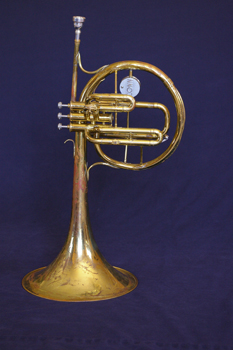
Horn Articles Online
The Mello Zone
In the United States today nearly every student horn player will encounter marching horns and mellophones.
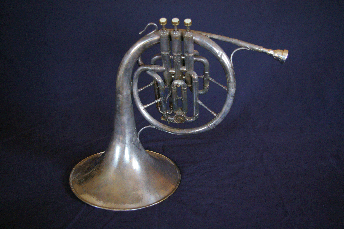 I first encountered the mellophone in F alto in high school in the late 1970s, as I was given a "classic" mellophone (or concert mellophone) by a family friend, the one pictured at right. This type of mellophone was used fairly widely in the United States from before the turn of the century until before WWII. Featuring
piston valves and fingered with the right hand, this instrument is an octave shorter than a standard single F horn and was generally used to play horn parts in amateur groups. While it is easier to play, it lacks some of the poetry of tone we associate with the horn. It is built to use a mouthpiece sized between that of a trumpet and trombone with a cornet shank.
I first encountered the mellophone in F alto in high school in the late 1970s, as I was given a "classic" mellophone (or concert mellophone) by a family friend, the one pictured at right. This type of mellophone was used fairly widely in the United States from before the turn of the century until before WWII. Featuring
piston valves and fingered with the right hand, this instrument is an octave shorter than a standard single F horn and was generally used to play horn parts in amateur groups. While it is easier to play, it lacks some of the poetry of tone we associate with the horn. It is built to use a mouthpiece sized between that of a trumpet and trombone with a cornet shank.
I did not march with a mellophone in high school or college, as Emporia High School, the Kansas Lions Band, and Emporia State University all marched standard French horns, which was not uncommon at that time. But being interested in horn history I even then started becoming familiar with other alto range brass instruments, including the mellophone and alto (tenor) horn.
Fast forward to the years I played in the Nashville Symphony. I also helped with horn sectionals at McGavock High School, and about 1994 they were in the process of buying new instruments. Besides the mellophones the directors where looking at I had them also get a Yamaha B-flat marching horn on trial. I did a playing test of all the different instruments. To my mind the B-flat marching horn was the best,
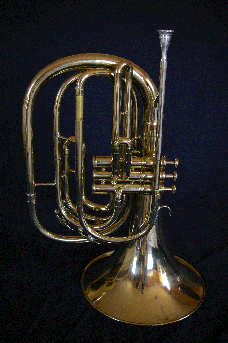 but the directors chose the best of the mellophones.
It is an instrument pitched in B-flat built to use a horn mouthpiece; the music for this instrument would be in F but fingered with B-flat horn fingerings, just like "thumb down" on a double horn. One is pictured at left.
but the directors chose the best of the mellophones.
It is an instrument pitched in B-flat built to use a horn mouthpiece; the music for this instrument would be in F but fingered with B-flat horn fingerings, just like "thumb down" on a double horn. One is pictured at left.
When I left Nashville to start teaching full time at the Crane School of Music in Potsdam, NY, life was good in a sense as they have no football team or marching band! I only had to talk about mellophones with the students in horn methods classes.
Fast forward again to 2007 and teaching full time at Arizona State. For the first six years of my tenure here they used B-flat marching horns in the marching band. However, people in high places wanted change in the athletic bands. As a part of that change a decision was made to replace the old marching horns (mostly purchased in the 1980s) with brand new mellophones, part of a large purchase of instruments and uniforms funded by an anonymous donor. The first one I tested is below. It is in F alto just like the classic mellophone at the top of the page, but it is built in a different shape and uses a more trumpet-like mouthpiece with a trumpet shank (although a smaller horn mouthpiece works fairly well with an adapter).
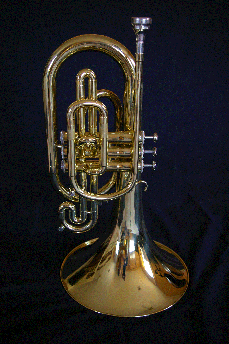 Initially I was not very happy about this turn of events. But it did get me thinking out of the box.
Initially I was not very happy about this turn of events. But it did get me thinking out of the box.
Overall, we do need more horn players. Most horn students today in the USA will play mellophone for a while somewhere, and it has in effect become a gateway instrument to the horn. If it were taught better it could be a part of the solution to the issue of there just not being enough good horn players around at the high school level.
The result was that during the summer and fall of 2007 I became very well acquainted with the mellophone. It is an ideal time to get to know the mellophone better, as the fact that DCI groups recently switched to standard band instruments has been a big boost to mellophones. They had long lagged behind other brass instruments, but now there is in fact a "renaissance" in progress with real development money and effort going into improved instruments and mouthpieces. Starting that summer I wrote not only a number of posts in my former blog (now a part of Horn Matters) but also wrote a book, the only one of the kind ever written, A Mello Catechism; A Guide to the World of Mellophones and Marching Horns.
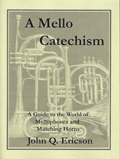 A Mello Catechism: A Guide to the World of Mellophones and Marching Horns
A Mello Catechism: A Guide to the World of Mellophones and Marching Horns
The mellophone is widely used today as a substitute for the horn
in marching bands and drum corps. This unique publication presents
information in a question and answer format on mellophone history,
related middle-brass instruments, mouthpiece choices, range
development, tone quality, intonation, fingering charts, warmup,
coping with marching, and much more. This updated third edition also
includes materials of interest to music educators and horn teachers
with limited mellophone experience.
My Mellophonium Mood
The classic jazz instrument from the 50s lives on; my experiences performing the instrument today
Since the completion of this project I have played mellophone from time to time in the praise band at my church, emulating the style of the classic jazz mellophone recordings from the 50s and 60s. In this case for me it functions much like the high F side on a descant or triple horn, and as the lone brass instrument in the group a mellophone played with a small tenor horn mouthpiece fit the texture of the music surprisingly well. Sort of a low Flugelhorn that I am not likely to chip notes on.
In the process of writing the book I also started posting about the mellophone in my blog, now part of the Horn Matters project. There are several posts there which I believe will be of continued interest among mellophone players and band directors that go beyond the contents of the book.
Above all I had hoped that these writings help encourage horn students as they traverse the "mellophone jungle" and maybe even inspire a few more mellophone players to switch over to the horn for concert season. We need more horn players!
Return to Horn Articles Online
